Latest ICOMOS publications
Received in 2023 at the ICOMOS Documentation Centre
ICOMOS
Volume XXI of the series Monuments and Sites published by ICOMOS is the second of the series (after volume XIX) to document the work on the Buddha figures and on the World Heritage Site in the Bamiyan Valley. The first chapter presents the latest research on the polychromy of the Buddha figures, while the second chapter documents the work of the ICOMOS working groups on site from 2010 to 2014. Chapter three provides among other things information on demining and includes a comprehensive contribution by the Department of Historical Monuments, Ministry of Information and Culture of Afghanistan. Constance Wyndham describes the opinions of the inhabitants of the Bamiyan Valley on the current situation. Chapter four contains historical reports on the Buddha figures and on the Bamiyan Valley and UNESCO reports, as well as the unpublished dissertation by Abdullah Amiryan, Renata Piarelli and Gabriele Bruckmann (1975/76), as well as remarkable photographic images by Dieter Blume (1976) and a small selection of press articles and essays on the current discussion about saving the fragments in the Buddha niches. The volume, with forewords by Mohammed Ashraf Ghani, President of the Islamic Republic of Afghanistan, Francesco Bandarin, Assistant Director-General of UNESCO and Gustavo Araoz, President of ICOMOS International, comprises more than 600 richly illustrated pages.
|
|
Living heritage provides people with their sense of identity and is continuously regenerating in response to their environment. But we live in a time of rapid environmental change accelerated by the current climate crisis. Our responses to this crisis have the potential to strengthen our living heritage or destroy it. With this in mind we invite you to explore the following questions:
|
|
|
ICOMOS & IUCN
Connecting Practice - Phase IV - Part 1: final report. Connecting Practice is a joint exploration by ICOMOS and IUCN aimed at learning and developing new approaches that recognise and harness the interconnection of natural and cultural values of highly significant heritage landscapes and seascapes to achieve more effective, creative and inclusive ways to maintain their heritage significance. Four phases have been implemented since Connecting Practice began in 2013. Each phase has contributed to increasing the awareness among heritage management actors about the close interrelations of the natural and cultural dimensions of heritage places and of the need for joint approaches in their protection and management. Multi-disciplinary fieldwork, resulting in collective experiential learning, has always been an integral part of the Connecting Practice working methods. Phase IV built on the insights and outcomes of Phase III, which explored whether and how resilience thinking approaches could be operationalised to better understand: (1) the interrelations among natural and cultural dimensions of heritage places; (2) the dynamics of change at the place level and (3) how to conceive and understand the possibility of very different futures for a heritage place.
Wayfinder Heritage: applying resilience thinking to long-term planning of heritage places. Connecting Practice phase IV: final report, part 2 - August 2023. Leticia Leitão, Steve Brown. ICOMOS & IUCN, 2023. 75 p. ISBN 978-2-918086-97-0. [English] Wayfinder Heritage is a ‘resilience thinking framework’ aimed at supporting long-term planning for World Heritage properties and other heritage places. It promotes discussion about what future is envisaged for a heritage place by expanding heritage management planning to include 20-year, 30-year, and longer horizons. The framework guides managers and other heritage custodians through a participatory process towards preparing a long-term strategy to influence desired change in a heritage place. Conceived as a complement to existing management planning processes, the framework is best applied in advance of preparing or updating a management plan. In this way, the longterm strategy provides the direction to follow beyond the period covered by the management plan, the latter usually limited to five-year or 10-year planning horizons. The strategy will help tackle existing and anticipated management challenges that require a long-term perspective, as well as direct multiple continuous actions such as climate change adaptation and mitigation, changing population dynamics, or large-scale conservation works following disasters. If the main goal of inscribing properties on the World Heritage List – or designating heritage places at the national, provincial, or local levels – is to protect them for present and future generations, their management requires approaches that are anchored in the past and incorporate long-term actions aimed at achieving a desired future. The framework is an adaptation of the Wayfinder guide (informed by elements of other resilience assessment methodologies) to suit the needs of integrated cultural and natural heritage management. It includes an introduction to resilience thinking in the context of heritage management, followed by practical guidance on how to implement the five-phase process through a series of participatory workshops. The Wayfinder Heritage framework was explored and tested at the World Heritage property of Hanseatic Town of Visby on the island of Gotland, Sweden. To reach its full potential, ICOMOS and IUCN are keen to support further testing of the framework at other heritage places.
|
UNESCO, ICCROM, ICOMOS & IUCN
The objective of this publication is to provide a self-assessment methodology to evaluate management effectiveness in a World Heritage property or other heritage place. It contains 12 tools that can be used separately or collectively to understand in detail what is working well and what can be done better. To facilitate their use, the tools are accompanied by worksheets, in the form of either a template to help compile information in a systematic way or a questionnaire, both of which can be adapted to the specific needs of each heritage place. The Toolkit supports managers in identifying ways to improve conservation practices, management processes and resource allocation – particularly if used before reviewing or updating management plans. The Toolkit also serves as a resource for capacity building and awareness raising about the management of World Heritage properties. It will form the basis of related capacity building activities provided by UNESCO, the Advisory Bodies and the UNESCO Category 2 Centres, and can also be used independently for self-directed learning. It is intended to support implementation of the World Heritage Convention itself, along with the Operational Guidelines.
|
ICOMOS Australia
The focus of this special issue of Historic Environment is to investigate current heritage practices in Australia, New Zealand and the Pacific by exploring how aspects of intangible cultural heritage (ICH) can be involved in understanding the significance of place. It highlights recent paradigm shifts in heritage discourse and practice that are influencing the way that heritage is being acknowledged in the region. Contributing authors articulate how diverse communities perceive elements of ICH essential to their respective identities. Collectively, they are concerned to demonstrate how recent understandings of heritage in the region may contribute towards developing more holistic practices to safeguard places of significance.
|
ICOMOS Belgium
The Thema section of this volume deals with fortified landscapes that surround us on all sides. Witness to the tensions between human groups over millennia, they have deeply shaped our urban and rural environment. While their physical imprint sometimes remains very present, the memory of their historical significance may have faded to the point of disappearance or, on the contrary, may have been perpetuated, sometimes amplified or distorted. History, even scientific history, cannot be completely objective. But the heritage curator, like the archivist, is committed to safeguarding first-hand accounts, material necessary for reflection and clues or evidence to be used in the investigation. The landscapes shaped by wars of all kinds are part of the memory of our societies. Ensuring their passing on to future generations is a major objective of civilisation.
|
ICOMOS France
A recent concern on the time scale of architectural and urban heritage of historic city centres, energy efficiency of existing buildings takes on a major and universal dimension in response to climate change. thermal renovation works will have consequences and may jeopardise the authenticity, the material and immaterial values of this heritage as witness to our history… How to conciliate conservation of the heritage and reduction of energy consumption as part of a sustainable development framework? This publication presents the proceedings of the symposium organized in Paris in October 2010 on this topic by ICOMOS France and Euromed Heritage.
|
|
Metallic statuary and decorations have particularly boomed between 1800 and 1945. When the upper middle class came to power, towns were reorganized, introducing public spaces in a renewed urban network, now containing open spaces, places, sculptures and gardens, then populated by allegories and symbols: fountains, great men sculptures, animal sculptures, war memorials, urban and architectural ornaments… The objective of this international conference is to review the present state of knowledge on conservation-restoration of those metallic ornaments, but also to confront views, approaches, methodologies, solutions, and results.
|
|
In the context of the different seminars and conferences which it organises on a regular basis, ICOMOS-France and its working group on heritage areas have had the opportunity to meet numerous elected representatives who, in their respective territories, are promoting projects founded on heritage assets, both natural and cultural. These different meetings have shown that there is an evolution in the way elected representatives and administrations view these projects. The successes met by some of them, as well as the difficulties encountered in their implementation, are the immediate inspiration for the methodological guidelines proposed here. The present guidelines are articulated in five points, within a general framework. These points are intended to be useful in organising and thinking about your own projects and in taking them to successful outcomes. They are recommendations which must be adjusted to the local context by a precise analysis of the working methods which ore best adapted to the activities and the particular character of the territory concerned.
|
|
At a time witnessing a revival of the wooden house, when engineering science allows to design ever taller wooden buildings, the questions associated with the conservation and use of wooden heritage deserve to be reconsidered: the relevance of archaeo-dendrometry techniques for authenticating works of art; methods for surveying and modelling structures to optimise the diagnosis of wooden monumental structures; recognition of disorders and resulting conclusions; relevant treatment methods; the time scale to be considered for the effective use of new wood-based materials. In this book, ICOMOS France and the French section of the International Conservation Institute (SFIIC) present the sum of discussions held at the symposium "Intervening on wooden heritage buildings: methods from yesterday to today", which took place from 4 to 6 November 2020 in partnership with the Historic Monuments Research Laboratory (LRMH) and the GDR. Architects, historians, curators, scientists, craftsmen and companies could share their knowledge and experience. This symposium focused on the various aspects of wood from architectural, technical and historical points of view, in closest proximity with building site issues, looked at international practices and showed that different cultures associated with this material have developed around the world. These cultures question our approaches to conservation, restoration and authenticity in the field of heritage. The French concept of wood conservation is compared with experiences in other countries, providing an opportunity for openness and mutual enrichment on this topic.
|
|
Le patrimoine au service de la solidarité ville-campagne : des atouts à conjuguer pour votre territoire. This booklet, part of the cycle "La parole aux élus" [Giving elected representative their say], makes up the proceedings of the Strasbourg workshop organised on 15 and 16 September 2022 by the ICOMOS France "Sites, landscapes and heritage areas" working group. Identifying the challenges shared by town and country makes it possible to reinvent equality between these two types of territorial economy, which for decades have been marked by subordination, contempt or antagonism. Today, these territories must join forces to face up to a globalised world that threatens urban harmony and rural well-being, destroying tboth he mutually beneficial links and the traditional interdependence balancing their relationship. The Strasbourg workshop explored a number of avenues for (re)building urban-rural neighbourhood solidarity in a wide range of areas. It was proposed that the issues should be structured along three lines: 1. sharing resources; 2. interlocking spatial scales and their implications for cooperation and flow management; 3. cooperation tools and means of governance. During this workshop, speakers in round tables could share their experience on concrete cases, illustrating the plurality of the notion of heritage and how it can rally people, bring them into action, inspire and drive projects. |
ICOMOS Germany
Proceedings of the International ICOMOS Conference of the Bulgarian and German National Committees in cooperation with the Municipality of Kazanlak, the Buzludzha Project Foundation and the Iskra History Museum. Kazanlak, Bulgaria, 22–23 July 2021
|
|
International meeting of the German national Committee of ICOMOS and the German Architecture Museum (DAM) in cooperation with the German UNESCO Commission and PERSPECTIV - Association of Historic Theatres in Europe, 16-17 September 2021. - The general renovation, occasionally also the comprehensive modernisation and extension of listed theatre buildings and opera houses is one of the major conservation and architectural tasks of the present day in Europe. Many houses and their ensembles can look back on a long tradition. They often owe their excellent international reputation to the outstanding artistic reputation of their ensembles and programmes, not infrequently linked to and reinforced by magnificent buildings that serve the performing arts as venues and the audience as auditoriums.
|
|
The former residence of the Würzburg prince-bishops is one of the best-known Baroque palace complexes in Europe and one of the most important art-historical treasures in the country. In 1981, it was the first site in Bavaria to be awarded the coveted title of World Heritage. From the laying of the foundation stone some 300 years ago to its completion six decades later, the residence complex was a superlative project. In total, the builders invested over 40 million euros in today's currency. In the process, the best artists of their time created an architectural jewel. Among other things, Balthasar Neumann's column-free vaulted staircase with its important and wonderful ceiling fresco by the Venetian Giovanni Battista Tiepolo is world-famous. The special history of the Würzburg Residenz also includes its destruction on 16 March 1945 and the subsequent decades of restoration to its former glory. The inscription of the Würzburg Residenz as a UNESCO World Heritage Site in 1981 also explicitly acknowledged the extraordinary achievement of the reconstruction and the many decisions taken in the conservation of monuments since 1945.
|
|
Proceedings of an international conference held on 11–12 November 2021 in Berlin and online, organized by ICOMOS Germany and the European Academy Berlin in partnership with the University of Groningen, Delft University of Technology, ISC Water and Heritage. Contributions : 1. Paulo Oliveira Ramos, On Water and the City: A Heritage for Lisbon 2. Rolf Höhmann, Water World Heritage 3. Andrea Oldani, Waters and Landscapes of Invention: For a New Interpretation of Water Heritage 4. Till F. Sonnemann, Not a drop of water – The Functioning of the Angkorian Baray, and Their Role Today 5. Henk van Schaik, Bridging Water-related Cultural Heritage and Water Management Challenges 6. Carola Hein, Water Works: Heritage and the Pursuit of Sustainable Practices.
|
ICOMOS Jordan
Today, despite the incredible wealth of cultural heritage sites in the Middle East, with over 100,000 sites in Jordan alone, the region remains poorly represented on the World Heritage List. We, in Jordan, are working closely with our international partners to remedy this imbalance. UNESCO has described cultural and natural heritage as “irreplaceable sources of life and inspiration,” and nowhere is this more true than in the unique and magnificent sites of Jordan. This book is an attempt to illustrate the rich diversity of Jordan’s cultural heritage sites, including those that have been successfully listed as well as sites that will be recognized in the future.
|
ICOMOS Serbia
|
ICOMOS SloveniaManagement of cultural heritage sites = Upravljanje območij kulturne dediščine. The topic of the third volume in the Monographic Publications series of ICOMOS Slovenia is the management of cultural heritage sites. This monograph is a way to commemorate the European Year of Cultural Heritage (EYCH), which was celebrated in 2018, and to relate to the central EYCH starting-points that underlined the significance of awareness-raising about cultural heritage belonging to all of us and the necessity to promote cultural innovation and collaboration of people and communities, while fostering commitment to responsible and sustainable tourism with cultural heritage. The central thought when selecting the articles was borrowed from Donald Insall: “Good planning is only good management.” Insall underlines that successful conservation and active life of cultural heritage sites are a consequence of a careful and interdisciplinary planning of development activities, taking into account the features of heritage to develop its potentials in a balanced way, including the economic and tourist opportunities of these sites. This book presents the management processes and also insight into the diverse set of approaches and successful practices, particularly in Southeast Europe.
|
|
Resilient heritage = Dediščina, ki kljubuje. The 4th ICOMOS Slovenia International Scientific Symposium, held in September 2021, focused on questions related to increasing the resilience of cultural heritage. The monograph at hand presents the contributions from the symposium, addressing various themes that are directly or indirectly related to the improvement of the state of cultural heritage in the circumstances of the increasingly intense impacts of climate change and conflicts with a broad range of backgrounds. (...) Thematically, the monograph is divided into three sections and an introductory plenary section, which highlights the comprehensive and multifaceted role of cultural heritage in ensuring greater resilience of the planet and quality of life for everyone. The transcript of the lecture by Andrew Potts, one of the world’s leading experts on cultural heritage and climate change, highlights the global climate situation and the role of cultural heritage in addressing it. It also focuses on the European Cultural Heritage Green Paper. The first section, titled “What Is the Situation and How Prepared Are We”, presents the contributions that focus on analysing and listing threats to the individual heritage areas and sites due to climate change, inappropriate land use, and politically-driven urban development, as described by Andrea Triff. Tanja Hohnec’s contribution sums up the Slovenian experience in dealing with climate change in the field of cultural heritage, describing the results of the international CHEERS project. The second section presents the key challenges. Here, the authors focus on the various approaches to increasing the resilience of heritage and, on the other hand, balancing the investments in energy efficiency measures, which is one of the society’s funadamental priorities in the current crisis. The third section, titled Cultural Heritage as an Example, presents the experience and examples of successful implementations and projects that increase the resilience of heritage and thus its contribution to sustainable development. The authors from Madrid outline the PROCOERS Plan of protecting the collections kept in the Museo Nacional Centro de Arte Reina Sofía. The article on the development of heritage resilience in the Mae Klong river basin presents lessons learned in Thailand, while the contribution on the revitalisation of the medieval fortress of Bijela Tabija describes the efforts of the experts from Bosnia and Herzegovina.
|
ICOMOS Spain
The climate emergency and current energy crisis has spurred frenetic renewable energy development throughout our landscapes, villages and cities. In this context, ICOMOS-Spain has united professionals from all over the country to work together to compile practices, ideas and concerns to ensure that our rich cultural heritage values are integrated into the implementation of these forms of more sustainable energy. To achieve this, we require a country-wide planning approach which includes a thorough analysis of each site to simplify decision making and minimize the impact on cultural assets (tangible and intangible). Current Spanish cultural heritage and environment legislation lacks specific information on how the impact of facilities and infrastructures on cultural assets should be assessed, both in the context of the Environmental Impact Assessment and the authorization for projects on protected cultural assets. Therefore, these Guidelines aim to help legislators, decision makers, government department technical staff, facility developers and project planners advance towards the much sought after compatibility between renewable energy and the conservation and protection of our cultural heritage values, using the Heritage Impact Assessment Methodology (HIA), published in mid- 2022 by UNESCO and its three advisory bodies, ICOMOS, IUCN and ICCROM. Finally, a series of interesting case studies from other European countries (Austria/Hungary, France, Germany and the United Kingdom) compiled by UNESCO and the French Ministry of Ecological Transition have been included.
|
ICOMOS Our Common Dignity - Rights-Based Approaches Working Group
This E-publication shares the key outcomes of more than 10 years of ICOMOS contributions to the promotion of rights-based approaches in the heritage context through the Our Common Dignity - Rights-Based Approaches Working Group (OCD-RBA Working Group). Our ambition is to inspire managers and caretakers of cultural heritage to further explore the merit of rights-based approaches for their work by providing documents, case studies, tools and links to the activities of the working group thus far. The following pages showcase how the OCD-RBA Working Group has engaged with rights in heritage management, particularly within the arena of World Heritage. It sets out a number of milestones along the path to achieving the goal of embedding rights-base-approaches into all areas of the work of ICOMOS, and it celebrates the international activities that have led to where the working group is today. Much has been achieved - yet there is still much to do.
|
Works written by ICOMOS members
Managing Disaster Risks to Cultural Heritage presents case studies from different regions in the world and establishes a framework for understanding, identifying, and analysing disaster risks to immovable cultural heritage. Featuring contributions from academics and practitioners from around the globe, the book presents a comprehensive view of the scholarship relating to cultural heritage, disaster risk preparedness, and post-disaster recovery. Particular attention is given to the complex and dynamic nature of disaster risks and how they evolve during different phases of a catastrophic event, especially as hazards can create secondary effects that have greater impacts on cultural heritage, infrastructure, and economy. Arguing that risk preparedness and mitigation have historically been secondary to reactive emergency and first aid response, the book demonstrates that preparedness plans based on sound risk assessments can prevent hazards from becoming disasters. Emphasising that the protection of cultural heritage through preparedness, mitigation actions, and risk adaptation measures – especially for climate change – can contribute to the resilience of societies, the book highlights the vital role of communities in such activities. Managing Disaster Risks to Cultural Heritage will be useful to students, professionals, and scholars studying and working with cultural heritage protection. It will be of particular interest to those working in the fields of cultural heritage, archaeology, conservation and preservation, sustainable development, and disaster studies. |
Publications received in 2022 at the ICOMOS Documentation Centre
Publications received in 2021 at the ICOMOS Documentation Centre
Publications received in 2020 at the ICOMOS Documentation Centre
Publications received in 2019 at the ICOMOS Documentation Centre
Publications received in 2018 at the ICOMOS Documentation Centre
Publications received in 2017 at the ICOMOS Documentation Centre
Publications received in 2016 at the ICOMOS Documentation Centre
Publications received in 2015 at the ICOMOS Documentation Centre
Publications received in 2014 at the ICOMOS Documentation Centre
Publications received in 2013 at the ICOMOS Documentation Centre
Publications received in 2012 at the ICOMOS Documentation Centre
Publications received in 2011 at the ICOMOS Documentation Centre

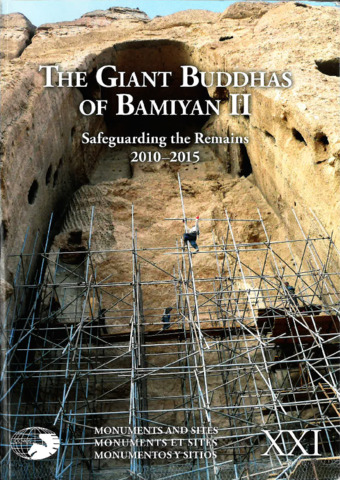 The giant Buddhas of Bamiyan II: safeguarding the remains 2010-2015. Edited by Erwin Emmeling and
The giant Buddhas of Bamiyan II: safeguarding the remains 2010-2015. Edited by Erwin Emmeling and 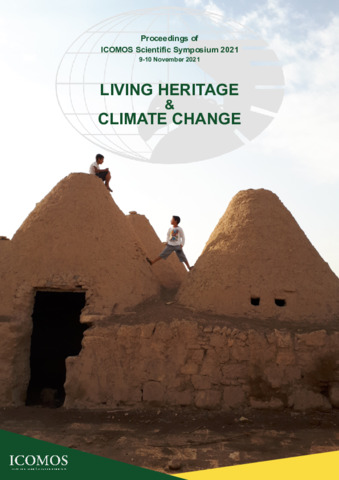 Living heritage and climate change: proceedings of ICOMOS scientific symposium 2021, 9-10 November 2021, online. Edited by Deirdre McDermott, Benthe Mathisen, Yasemin Sarıkaya Levent et al. ICOMOS, 2023. 205 p. ISBN 978-2-918086-75-8 [English, French, Spanish]
Living heritage and climate change: proceedings of ICOMOS scientific symposium 2021, 9-10 November 2021, online. Edited by Deirdre McDermott, Benthe Mathisen, Yasemin Sarıkaya Levent et al. ICOMOS, 2023. 205 p. ISBN 978-2-918086-75-8 [English, French, Spanish]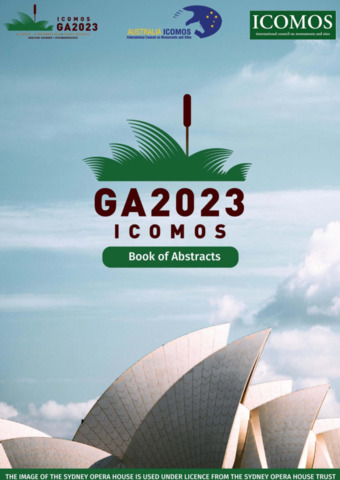 Heritage changes: ICOMOS 21st general assembly and scientific symposium. Sydney, Australia, 1-8 September 2023. Book of abstracts. Edited by Steve Brown and Ona Vileikis. ICOMOS, 2023. 477 p. ISBN 978-2-918086-90-1 [English, French, Spanish]
Heritage changes: ICOMOS 21st general assembly and scientific symposium. Sydney, Australia, 1-8 September 2023. Book of abstracts. Edited by Steve Brown and Ona Vileikis. ICOMOS, 2023. 477 p. ISBN 978-2-918086-90-1 [English, French, Spanish] Leticia Leitão, Steve Brown. ICOMOS & IUCN, 2023. 53 p. ISBN 978-2-918086-96-3. [English] [French]
Leticia Leitão, Steve Brown. ICOMOS & IUCN, 2023. 53 p. ISBN 978-2-918086-96-3. [English] [French]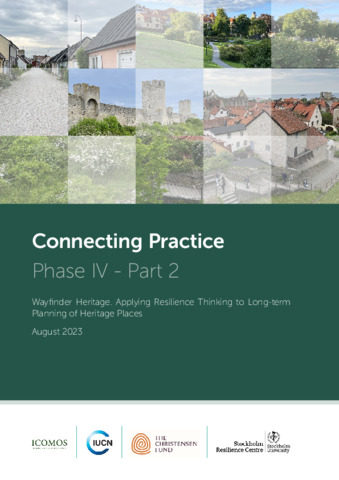
 Enhancing our heritage toolkit 2.0: assessing management effectiveness of World Heritage properties and other heritage places. Edited by Laura Frank, Eugene Jo, Leticia Leitão, Carlo Ossola. UNESCO, ICCROM, ICOMOS & UICN, 2023. 132 p. ISBN 978-92-3-100623-4 [English]
Enhancing our heritage toolkit 2.0: assessing management effectiveness of World Heritage properties and other heritage places. Edited by Laura Frank, Eugene Jo, Leticia Leitão, Carlo Ossola. UNESCO, ICCROM, ICOMOS & UICN, 2023. 132 p. ISBN 978-92-3-100623-4 [English]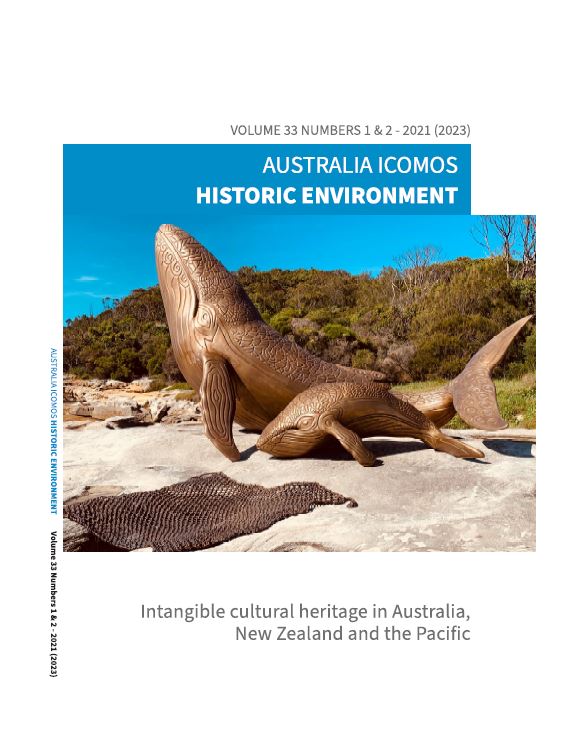 Intangible cultural heritage in Australia, New Zealand and the Pacific. Edited by Tracy Ireland, Amy Clarke, Rebecca Hawcroft et al. ICOMOS Australia, 2021-2023. 176 p. (Historic Environment, ISSN 0726-6715; vol. 33 n° 1 & 2). [English]
Intangible cultural heritage in Australia, New Zealand and the Pacific. Edited by Tracy Ireland, Amy Clarke, Rebecca Hawcroft et al. ICOMOS Australia, 2021-2023. 176 p. (Historic Environment, ISSN 0726-6715; vol. 33 n° 1 & 2). [English] Paysages fortifiés. Edited by Stéphane Demeter. ICOMOS Wallonie-Bruxelles, 2014. 71 p. (Thema & Collecta, 3). ISBN 978-2-9600205-4-0 [French]
Paysages fortifiés. Edited by Stéphane Demeter. ICOMOS Wallonie-Bruxelles, 2014. 71 p. (Thema & Collecta, 3). ISBN 978-2-9600205-4-0 [French] Le patrimoine : un modèle de développement durable. Quelles performances énergétiques pour le patrimoine architectural et urbain en Europe et en Méditerranée ? = Heritage: a model for sustainable development. How to improve energy performance in European and Mediterranean architectural and urban heritage? Edited by Christophe Graz, Michèle Tilmont and Cédric Gottfried. ICOMOS France, 2011. 120 p. (Les Cahiers d'ICOMOS France, 26). [French, English]
Le patrimoine : un modèle de développement durable. Quelles performances énergétiques pour le patrimoine architectural et urbain en Europe et en Méditerranée ? = Heritage: a model for sustainable development. How to improve energy performance in European and Mediterranean architectural and urban heritage? Edited by Christophe Graz, Michèle Tilmont and Cédric Gottfried. ICOMOS France, 2011. 120 p. (Les Cahiers d'ICOMOS France, 26). [French, English]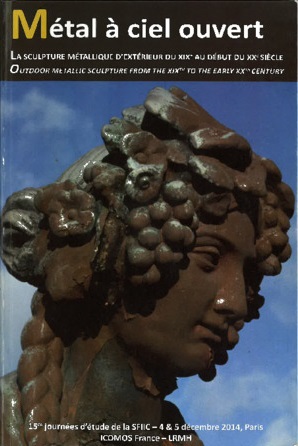 Métal à ciel ouvert : la sculpture métallique d'extérieur du XIXe au début du XXe siècle. Identification, conservation, restauration = Open air metal: outdoor metallic sculpture from the XIXth to the early XXth century. Identification, conservation, restoration. Aurélia Azéma (ed.), Annick Texier (ed.). Section française de l'institut international de conservation, 2014. 284 p. ISBN 978-2-905430-18-2 [French & English]
Métal à ciel ouvert : la sculpture métallique d'extérieur du XIXe au début du XXe siècle. Identification, conservation, restauration = Open air metal: outdoor metallic sculpture from the XIXth to the early XXth century. Identification, conservation, restoration. Aurélia Azéma (ed.), Annick Texier (ed.). Section française de l'institut international de conservation, 2014. 284 p. ISBN 978-2-905430-18-2 [French & English]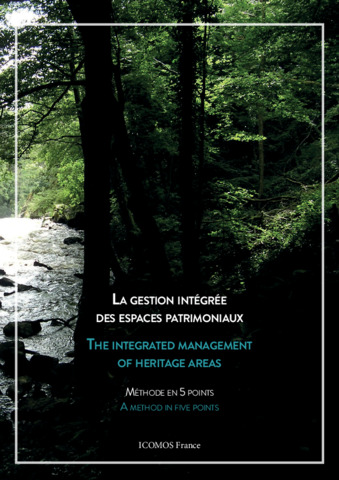 La gestion intégrée des espaces patrimoniaux : méthode en 5 points = The integrated management of heritage areas: a method in 5 points. Edited by Anne-Sophie Barré, Marc Gueyda, Isabelle Palmi et al. ICOMOS France, 2020. 18 p. (Les Cahiers d'ICOMOS France, 31). [French, English]
La gestion intégrée des espaces patrimoniaux : méthode en 5 points = The integrated management of heritage areas: a method in 5 points. Edited by Anne-Sophie Barré, Marc Gueyda, Isabelle Palmi et al. ICOMOS France, 2020. 18 p. (Les Cahiers d'ICOMOS France, 31). [French, English]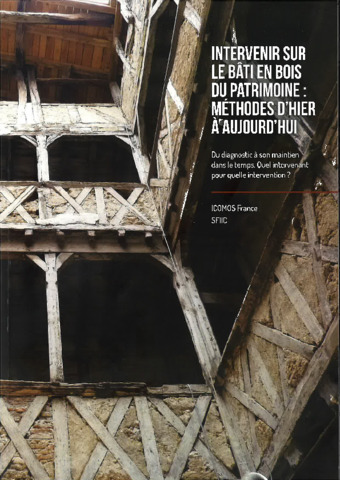 Intervenir sur le bâti en bois : méthodes d'hier à aujourd'hui. Du diagnostic à son maintien dans le temps: Quel intervenant pour quelle intervention ? Edited by Anne-Sophie Barré. ICOMOS France & Section française de l'institut international de conservation, 2021. 265 p. (Les Cahiers d'ICOMOS France, 33) [French, English]
Intervenir sur le bâti en bois : méthodes d'hier à aujourd'hui. Du diagnostic à son maintien dans le temps: Quel intervenant pour quelle intervention ? Edited by Anne-Sophie Barré. ICOMOS France & Section française de l'institut international de conservation, 2021. 265 p. (Les Cahiers d'ICOMOS France, 33) [French, English]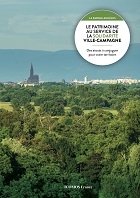 Edited by Anne-Catherine Gamerdinger, Marc Gayda, Chloé Mirouze et al. ICOMOS France, 2022. 153 p. (Les Cahiers d'ICOMOS France, ISSN 0297-3189; 34). [French]
Edited by Anne-Catherine Gamerdinger, Marc Gayda, Chloé Mirouze et al. ICOMOS France, 2022. 153 p. (Les Cahiers d'ICOMOS France, ISSN 0297-3189; 34). [French]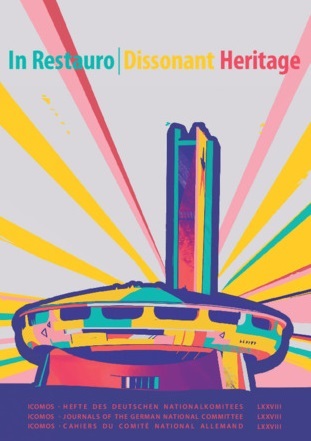 In restauro: post-war heritage of art and architecture in Central and Eastern Europe - integrated approaches to dissonant monuments and sites. Edited by Jörg Haspel, Jana Weydt, John Ziesemer. Hendrik Bäßler Verlag, 2023. 156 p. (ICOMOS Hefte des Deutschen Nationalkomitees, 78). ISBN 978-3-910447-09-7 [English]
In restauro: post-war heritage of art and architecture in Central and Eastern Europe - integrated approaches to dissonant monuments and sites. Edited by Jörg Haspel, Jana Weydt, John Ziesemer. Hendrik Bäßler Verlag, 2023. 156 p. (ICOMOS Hefte des Deutschen Nationalkomitees, 78). ISBN 978-3-910447-09-7 [English]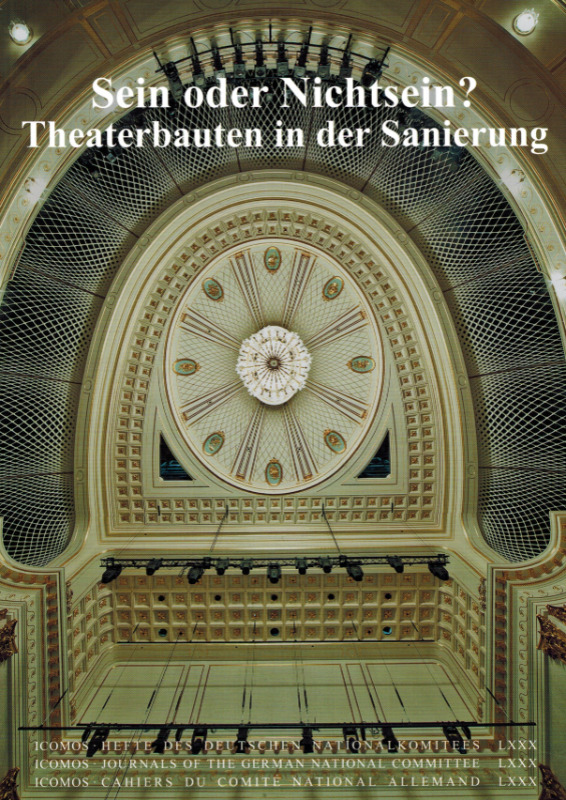 Sein oder Nichtsein? Theaterbauten in der Sanierung. Edited by Sigrid Brandt, Jörg Haspel and John Ziesemer. Hendrik Bäßler Verlag, 2023. 206 p. (ICOMOS Hefte des Deutschen Nationalkomitees, 80). ISBN 978-3-910447-09-7 [German]
Sein oder Nichtsein? Theaterbauten in der Sanierung. Edited by Sigrid Brandt, Jörg Haspel and John Ziesemer. Hendrik Bäßler Verlag, 2023. 206 p. (ICOMOS Hefte des Deutschen Nationalkomitees, 80). ISBN 978-3-910447-09-7 [German]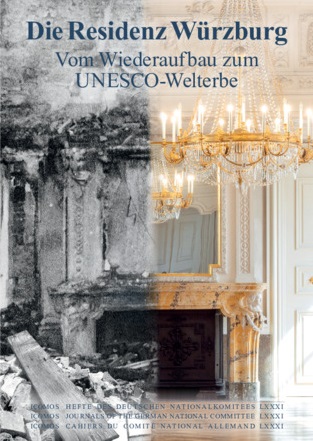 Die Residenz Würzburg: vom Wiederaufbau zum UNESCO-Welterbe - Rückblick und Herausforderung. Edited by Alexander Wiesneth and Ursula Schädler-Saub. Hendrik Bäßler Verlag, 2023. 175 p. (ICOMOS Hefte des Deutschen Nationalkomitees, 81). ISBN 978-3-910447-13-4 [German]
Die Residenz Würzburg: vom Wiederaufbau zum UNESCO-Welterbe - Rückblick und Herausforderung. Edited by Alexander Wiesneth and Ursula Schädler-Saub. Hendrik Bäßler Verlag, 2023. 175 p. (ICOMOS Hefte des Deutschen Nationalkomitees, 81). ISBN 978-3-910447-13-4 [German]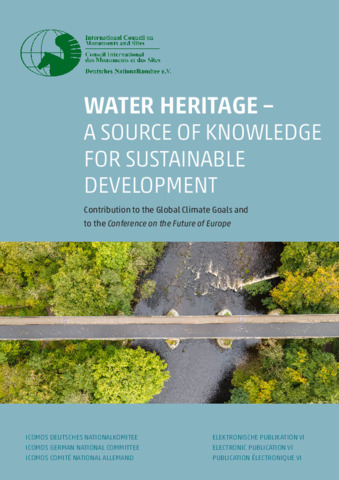 Water heritage - a source of knowledge for sustainable development: contribution to the global climate goals and to the Conference on the future of Europe. Edited by Jana Weydt and John Ziesemer. ICOMOS Germany, 2023. 59 p. ISBN 978-3-00-075921-5. [English]
Water heritage - a source of knowledge for sustainable development: contribution to the global climate goals and to the Conference on the future of Europe. Edited by Jana Weydt and John Ziesemer. ICOMOS Germany, 2023. 59 p. ISBN 978-3-00-075921-5. [English]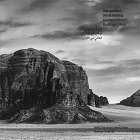 Unique and outstanding: Jordan's World Heritage sites. Dana Firas, Bashar Tabbas. ICOMOS Jordan, 2022. 249 p. ISBN 978-9923-9922-0-3 [English, Arabic]
Unique and outstanding: Jordan's World Heritage sites. Dana Firas, Bashar Tabbas. ICOMOS Jordan, 2022. 249 p. ISBN 978-9923-9922-0-3 [English, Arabic] Модерна Конзервациjа 10 = Modern Conservation 10. Edited by Branka Šekarić and Sanja Kesić Ristić. ICOMOS Serbia, 2022. 307 p. ISBN 978-9923-9922-0-3 [English & Serbian]
Модерна Конзервациjа 10 = Modern Conservation 10. Edited by Branka Šekarić and Sanja Kesić Ristić. ICOMOS Serbia, 2022. 307 p. ISBN 978-9923-9922-0-3 [English & Serbian]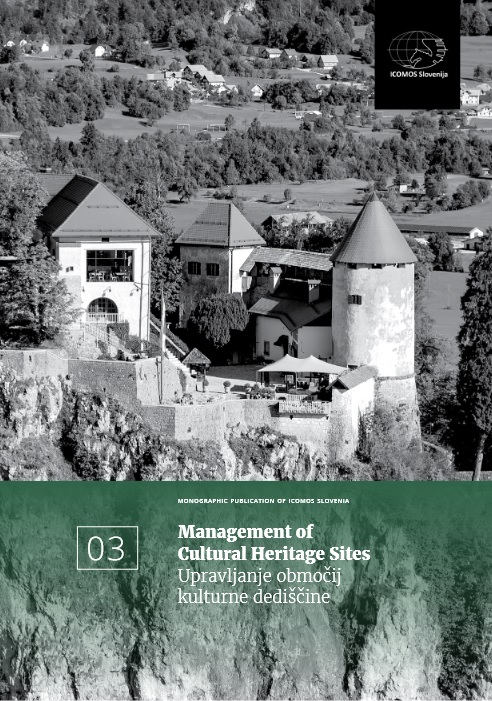 Edited by Sonja Ifko and Jelka Pirkovič. ICOMOS Slovenia & Slovensko nacionalno združenje za spomenike in spomeniška območja, 2019. 147p. (Monographic Publication of Icomos Slovenia, 3). ISBN 978-961-94851-0-1 [English, Slovenian]
Edited by Sonja Ifko and Jelka Pirkovič. ICOMOS Slovenia & Slovensko nacionalno združenje za spomenike in spomeniška območja, 2019. 147p. (Monographic Publication of Icomos Slovenia, 3). ISBN 978-961-94851-0-1 [English, Slovenian]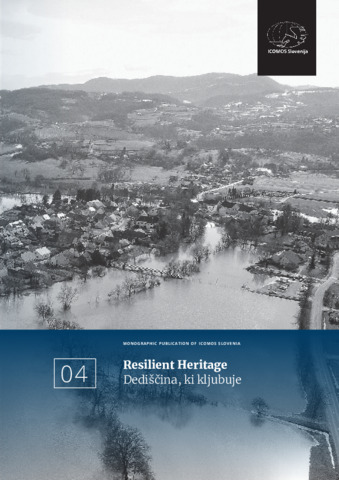 Edited by Sonja Ifko. ICOMOS Slovenia & Slovensko nacionalno združenje za spomenike in spomeniška območja, 2022. 190 p. (Monographic Publication of Icomos Slovenia, 4). ISBN 978-961-94851-4-9 [English, Slovenian]
Edited by Sonja Ifko. ICOMOS Slovenia & Slovensko nacionalno združenje za spomenike in spomeniška območja, 2022. 190 p. (Monographic Publication of Icomos Slovenia, 4). ISBN 978-961-94851-4-9 [English, Slovenian]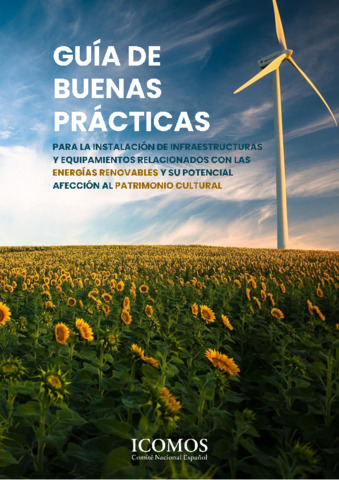 Guía de buenas prácticas para la instalación de infraestructuras y equipamientos relacionados con las energías renovables y su potencial afección al patrimonio cultural = Guidelines for the installation of renewable energy-related infrastructures and equipment and their potential impact on cultural heritage. José Alberto Alonso Campanero, Clara Villalba Montaner and Camino Enríquez Traba. ICOMOS Spain, 2023. 85 p. [Spanish] [English]
Guía de buenas prácticas para la instalación de infraestructuras y equipamientos relacionados con las energías renovables y su potencial afección al patrimonio cultural = Guidelines for the installation of renewable energy-related infrastructures and equipment and their potential impact on cultural heritage. José Alberto Alonso Campanero, Clara Villalba Montaner and Camino Enríquez Traba. ICOMOS Spain, 2023. 85 p. [Spanish] [English]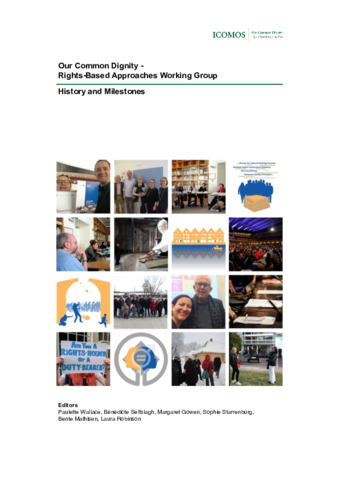 Our Common Dignity - Rights-Based Approaches Working Group: history and milestones. Edited by Paulette Wallace, Bénédicte Selfslagh, Margaret Gowen et al. ICOMOS, 2023. 132 p. ISBN 978-2-918086-94-9. [English]
Our Common Dignity - Rights-Based Approaches Working Group: history and milestones. Edited by Paulette Wallace, Bénédicte Selfslagh, Margaret Gowen et al. ICOMOS, 2023. 132 p. ISBN 978-2-918086-94-9. [English] 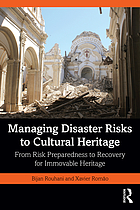 Managing disaster risks to cultural heritage: from risk preparedness to recovery for immovable heritage. Edited by Bijan Rouhani and Xavier Romão. Routledge, 2023. 291 p. ISBN 978-1-03-220453-6 (paperback). [English]
Managing disaster risks to cultural heritage: from risk preparedness to recovery for immovable heritage. Edited by Bijan Rouhani and Xavier Romão. Routledge, 2023. 291 p. ISBN 978-1-03-220453-6 (paperback). [English] 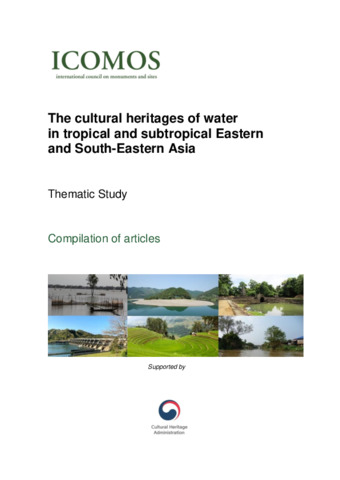 The cultural heritages of water in tropical and subtropical Eastern and South-Eastern Asia. Thematic study. Compilation of articles.
The cultural heritages of water in tropical and subtropical Eastern and South-Eastern Asia. Thematic study. Compilation of articles. 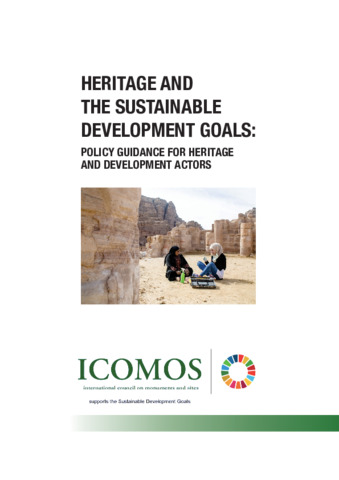 Heritage and the sustainable development goals: policy guidance for heritage and development actors. Sophia Labadi, Francesca Giliberto, Ilaria Rosetti, Linda Shetabi, Ege Yildirim. ICOMOS, 2021 [English] & 2022 [French]. 134 p. illus. (PDF)
Heritage and the sustainable development goals: policy guidance for heritage and development actors. Sophia Labadi, Francesca Giliberto, Ilaria Rosetti, Linda Shetabi, Ege Yildirim. ICOMOS, 2021 [English] & 2022 [French]. 134 p. illus. (PDF)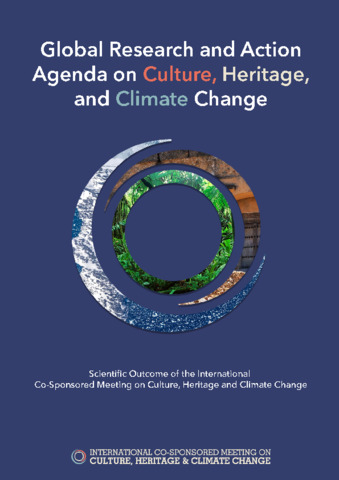 Global research and action agenda on culture, heritage and climate change. Hana Morel, William Megarry, Andrew Potts et al. ICOMOS & ISCM CHC, 2022. 75 p. ISBN 978-2-918086-69-7 (PDF) [English] - 978-2-918086-70-3 (print) [English] - 978-2-918086-79-6 (PDF) [French]
Global research and action agenda on culture, heritage and climate change. Hana Morel, William Megarry, Andrew Potts et al. ICOMOS & ISCM CHC, 2022. 75 p. ISBN 978-2-918086-69-7 (PDF) [English] - 978-2-918086-70-3 (print) [English] - 978-2-918086-79-6 (PDF) [French]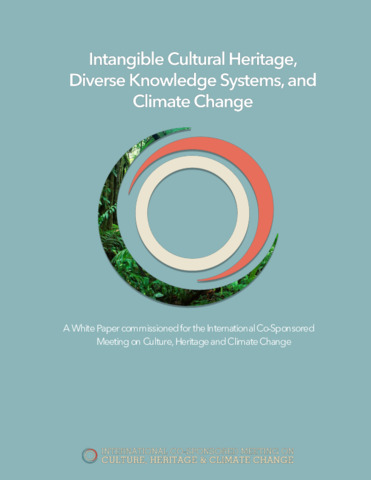 ICSM CHC White Paper I: Intangible cultural heritage, diverse knowledge systems and climate change. Contribution of Knowledge Systems Group I to the International Co-Sponsored Meeting on Culture, Heritage and Climate Change. Ben Orlove, Neil Dawson, Pasang Sherpa et al. ICOMOS & ISCM CHC, 2022. 103 p. ISBN 978-2-918086-71-0 (PDF) [English]
ICSM CHC White Paper I: Intangible cultural heritage, diverse knowledge systems and climate change. Contribution of Knowledge Systems Group I to the International Co-Sponsored Meeting on Culture, Heritage and Climate Change. Ben Orlove, Neil Dawson, Pasang Sherpa et al. ICOMOS & ISCM CHC, 2022. 103 p. ISBN 978-2-918086-71-0 (PDF) [English]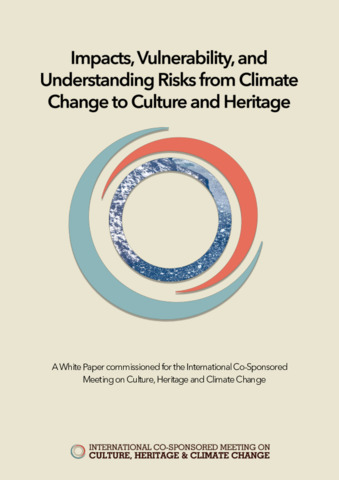 ICSM CHC White Paper II: Impacts, vulnerability, and understanding risks of climate change for culture and heritage: Contribution of Impacts Group II to the International Co-Sponsored Meeting on Culture, Heritage and Climate Change. Nicholas P. Simpson, Scott Allan Orr, Salma Sabour et al. ICOMOS & ISCM CHC, 2022.109 p. ISBN 978-2-918086-72-7 (PDF) [English]
ICSM CHC White Paper II: Impacts, vulnerability, and understanding risks of climate change for culture and heritage: Contribution of Impacts Group II to the International Co-Sponsored Meeting on Culture, Heritage and Climate Change. Nicholas P. Simpson, Scott Allan Orr, Salma Sabour et al. ICOMOS & ISCM CHC, 2022.109 p. ISBN 978-2-918086-72-7 (PDF) [English]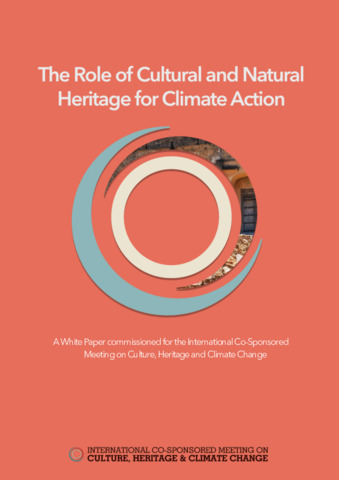 ICSM CHC White Paper III: The role of cultural and natural heritage for climate action: Contribution of Impacts Group III to the International Co-Sponsored Meeting on Culture, Heritage and Climate Change. Nick Shepherd, Joshua Benjamin Cohen, William Carmen et al. ICOMOS & ISCM CHC, 2022. 91 p. ISBN 978-2-918086-73-4 (PDF) [English]
ICSM CHC White Paper III: The role of cultural and natural heritage for climate action: Contribution of Impacts Group III to the International Co-Sponsored Meeting on Culture, Heritage and Climate Change. Nick Shepherd, Joshua Benjamin Cohen, William Carmen et al. ICOMOS & ISCM CHC, 2022. 91 p. ISBN 978-2-918086-73-4 (PDF) [English]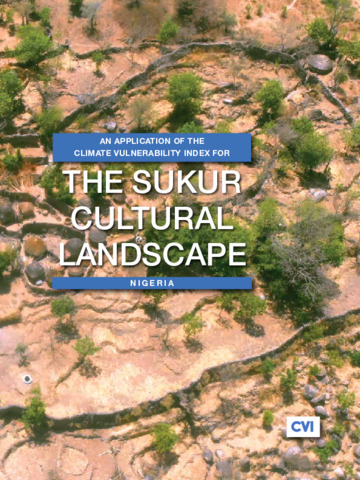 An application of the Climate Vulnerability Index for the Sukur Cultural Landscape. Jon C. Day, Scott F. Heron, Ishanlosen Odiaua et al. ICOMOS Nigeria, 2022. 60 p. ISBN 978-2-918086-83-3 (PDF) [English]
An application of the Climate Vulnerability Index for the Sukur Cultural Landscape. Jon C. Day, Scott F. Heron, Ishanlosen Odiaua et al. ICOMOS Nigeria, 2022. 60 p. ISBN 978-2-918086-83-3 (PDF) [English]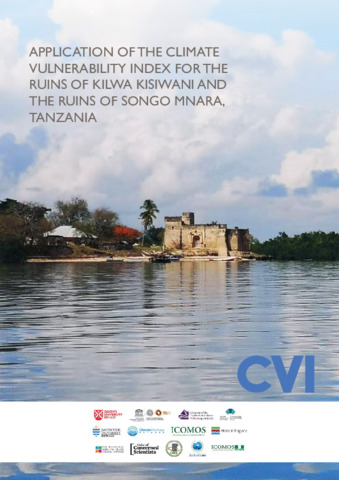 Application of the Climate Vulnerability Index for the Ruins of Kilwa Kisiwani and the Ruins of Songo Mnara, Tanzania. Scott F. Heron, Jon D. Day, Mercy Mbogelah et al. CVI Africa Project, 2022. 52 p. ISBN 978-2-918086-84-0 (PDF) [English] - 978-2-918086-85-7 (PDF) [Swahili]
Application of the Climate Vulnerability Index for the Ruins of Kilwa Kisiwani and the Ruins of Songo Mnara, Tanzania. Scott F. Heron, Jon D. Day, Mercy Mbogelah et al. CVI Africa Project, 2022. 52 p. ISBN 978-2-918086-84-0 (PDF) [English] - 978-2-918086-85-7 (PDF) [Swahili]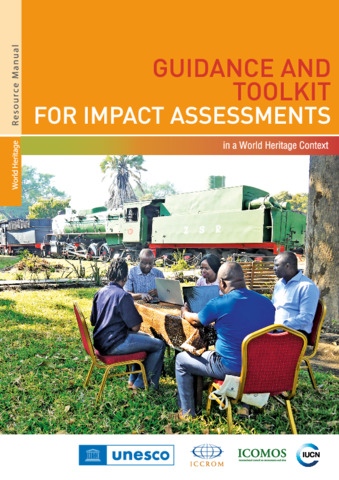 Guidance and toolkit for impact assessments in a World Heritage context. Sarah Court, Eugene Jo, Richard Mackay et al. UNESCO, ICCROM, ICOMOS et UICN, 2022. 87 p. ISBN 978-92-3-100535-0 (PDF) [English]
Guidance and toolkit for impact assessments in a World Heritage context. Sarah Court, Eugene Jo, Richard Mackay et al. UNESCO, ICCROM, ICOMOS et UICN, 2022. 87 p. ISBN 978-92-3-100535-0 (PDF) [English]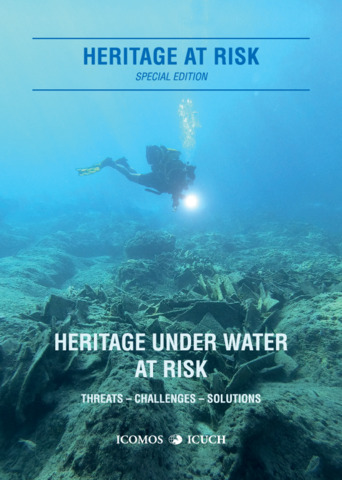 Heritage Under Water at Risk: Threats, Challenges and Solutions. Albert Hafner (ed.), Hakan Öniz (ed.), Lucy Semaan (ed.), Christopher Underwood (ed.). ICOMOS, 2022. 215 p. (Heritage at Risk, special edition.) ISBN 978-2-918086-37-6 (print), 978-2-918086-38-3 (PDF). [English]
Heritage Under Water at Risk: Threats, Challenges and Solutions. Albert Hafner (ed.), Hakan Öniz (ed.), Lucy Semaan (ed.), Christopher Underwood (ed.). ICOMOS, 2022. 215 p. (Heritage at Risk, special edition.) ISBN 978-2-918086-37-6 (print), 978-2-918086-38-3 (PDF). [English] Regenerating cultural religious heritage: intercultural dialogue on places of religion and rituals. Olimpia Niglio, Andrea Longhi, Henrik Lindblad et al. Springer, 2022. 300 p. ISBN 978-981-19-3469-8 (print), 978-981-19-3470-4 (PDF) [English]
Regenerating cultural religious heritage: intercultural dialogue on places of religion and rituals. Olimpia Niglio, Andrea Longhi, Henrik Lindblad et al. Springer, 2022. 300 p. ISBN 978-981-19-3469-8 (print), 978-981-19-3470-4 (PDF) [English] Religious heritage: Celebrating and conserving places of religious and ritual significance in a global world and changing climates. ICOMOS scientific symposium 2022 book of abstracts. 29-30 October 2022, Fine Arts department, Bangkok, Thailand. ICOMOS, 2022. 135 p. [English & French]
Religious heritage: Celebrating and conserving places of religious and ritual significance in a global world and changing climates. ICOMOS scientific symposium 2022 book of abstracts. 29-30 October 2022, Fine Arts department, Bangkok, Thailand. ICOMOS, 2022. 135 p. [English & French]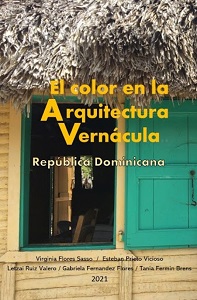
 The look of leisure: Historic seaside villas of the Northern Baltic. Laura Berger (éd.). Helsinki: ICOMOS Finland & Finnish Architecture Society, 2021. 205 p. ISBN 978-952-68812-6-3 (print). [English]
The look of leisure: Historic seaside villas of the Northern Baltic. Laura Berger (éd.). Helsinki: ICOMOS Finland & Finnish Architecture Society, 2021. 205 p. ISBN 978-952-68812-6-3 (print). [English]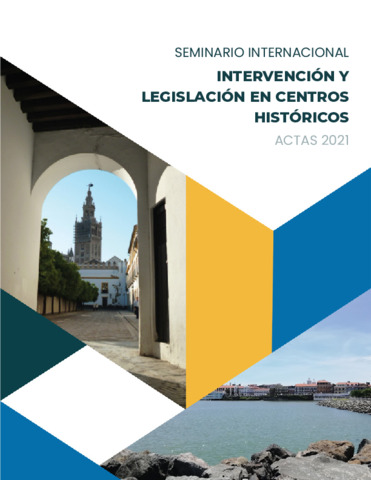 Seminario Internacional "Intervención y legislación en centros históricos". 22-26 February 2021, Panamá. Actas. Silvia Arroyo Duarte, Antonio Cubero Hernández, María Teresa Pérez Cano et al. ICOMOS Panama, 2022. 107 p. ISBN 978-0-9568370-1-1 (PDF) [Spanish]
Seminario Internacional "Intervención y legislación en centros históricos". 22-26 February 2021, Panamá. Actas. Silvia Arroyo Duarte, Antonio Cubero Hernández, María Teresa Pérez Cano et al. ICOMOS Panama, 2022. 107 p. ISBN 978-0-9568370-1-1 (PDF) [Spanish]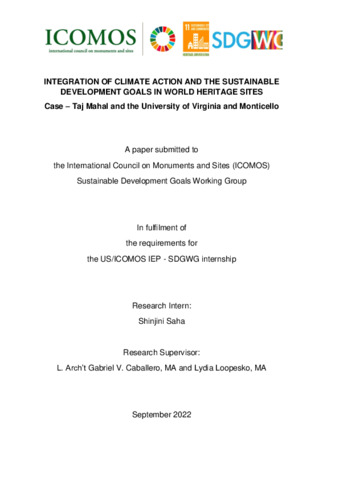 Integration of climate action and the sustainable development goals in World Heritage sites: Case – Taj Mahal and the University of Virginia and Monticello. Shinjini Saha, Caballero, Gabriel Victor, Lydia Loopesko. ICOMOS SDG WG, 2022. 83 p. (PDF) [English]
Integration of climate action and the sustainable development goals in World Heritage sites: Case – Taj Mahal and the University of Virginia and Monticello. Shinjini Saha, Caballero, Gabriel Victor, Lydia Loopesko. ICOMOS SDG WG, 2022. 83 p. (PDF) [English]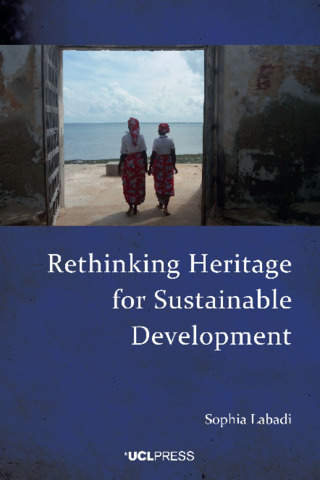 Rethinking heritage for sustainable development. Sophia Labadi. London, UK: UCL Press, 2022. 244 p. ISBN 978-1-80008-194-9 (hardback), 978-1-80008-193-2 (paperback), 978-1-80008- 192-5 (PDF), 978-1-80008-195-6 (epub). [English]
Rethinking heritage for sustainable development. Sophia Labadi. London, UK: UCL Press, 2022. 244 p. ISBN 978-1-80008-194-9 (hardback), 978-1-80008-193-2 (paperback), 978-1-80008- 192-5 (PDF), 978-1-80008-195-6 (epub). [English]  2020 ICOMOS 6 ISCs Joint Meeting Proceedings: Advancing Risk Management for the Shared Future. Conference Volume. Bureau of Cultural Heritage, Ministry of Culture, Taiwan, R.O.C, Taiwan, 332 p. [Eng]
2020 ICOMOS 6 ISCs Joint Meeting Proceedings: Advancing Risk Management for the Shared Future. Conference Volume. Bureau of Cultural Heritage, Ministry of Culture, Taiwan, R.O.C, Taiwan, 332 p. [Eng]


 Current research in heritage and conservation studies from Australia and New Zealand. eritage, sustainability and social justice. Volume 31, No. 1. Ireland, Tracy (ed.) Victoria, Australia Icomos, 2020. 116 p. [Eng]
Current research in heritage and conservation studies from Australia and New Zealand. eritage, sustainability and social justice. Volume 31, No. 1. Ireland, Tracy (ed.) Victoria, Australia Icomos, 2020. 116 p. [Eng]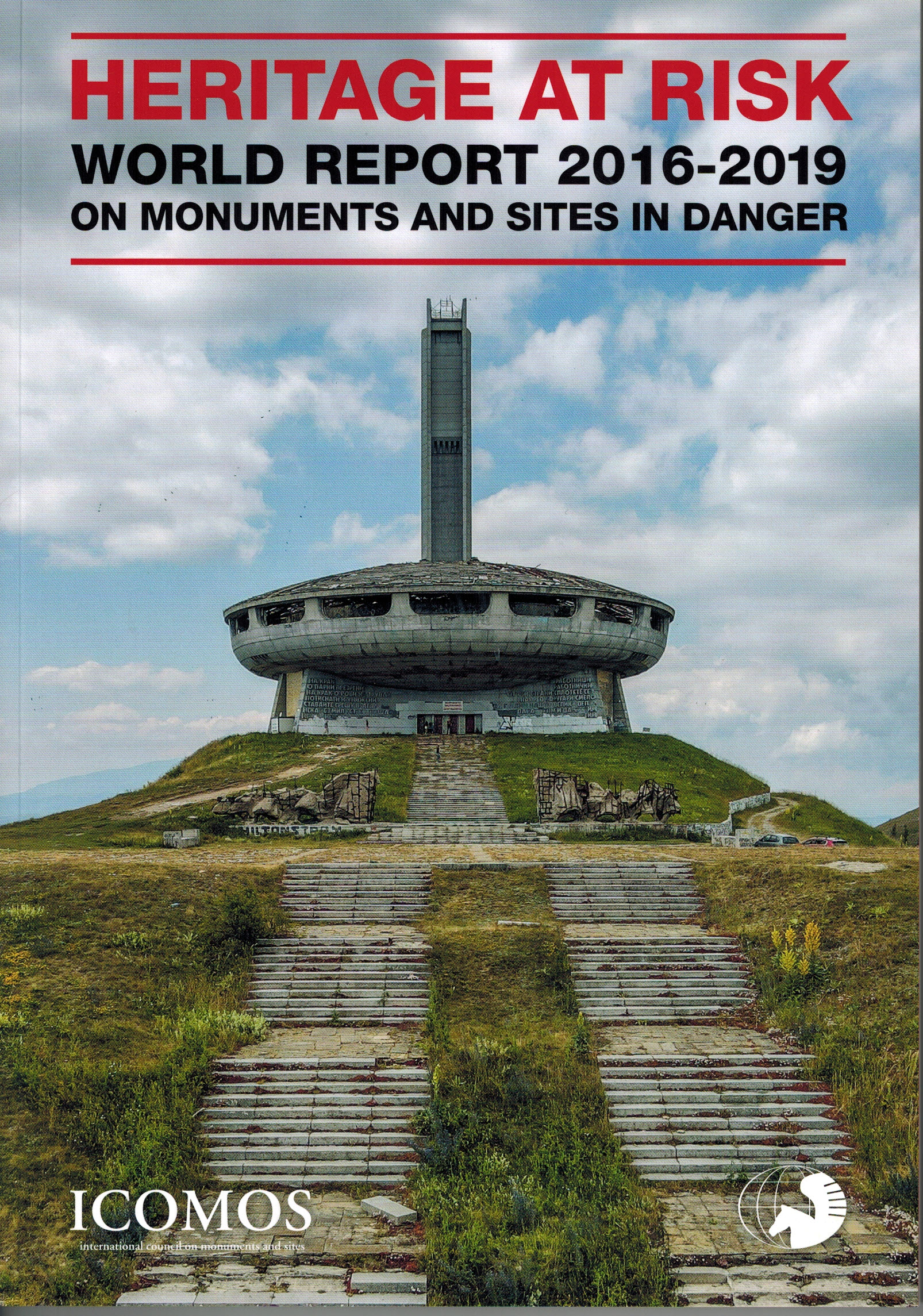



 Tech im 19. Jahrhundert. Ziesemer, John (ed.). Berlin: Hendrik Bäβler Verlag, 2019 (ICOMOS - Hefte des Deutschen Nationalkomitees LXX). [Eng & Ger]
Tech im 19. Jahrhundert. Ziesemer, John (ed.). Berlin: Hendrik Bäβler Verlag, 2019 (ICOMOS - Hefte des Deutschen Nationalkomitees LXX). [Eng & Ger] 100 Godina Bahausa. Turkušić Jurić, Elša (ed.). Sarajevo, National Committee of ICOMOS in Bosnia and Herzegovina, 2020. 104 p. [Bos]
100 Godina Bahausa. Turkušić Jurić, Elša (ed.). Sarajevo, National Committee of ICOMOS in Bosnia and Herzegovina, 2020. 104 p. [Bos] Modern Conservation No.7. Šekaric, Branka (ed.). Belgrade, ICOMOS Serbie, 2019, 241 p.illus. [Ser, summaries in Eng]
Modern Conservation No.7. Šekaric, Branka (ed.). Belgrade, ICOMOS Serbie, 2019, 241 p.illus. [Ser, summaries in Eng] Monumentos y Sitios: Uruguay. Béhèran, Ricardo (ed.), Mazzini, Elena (ed.). Montevideo, ICOMOS Uruguay, 2019. 208 p., illus. [Spa, résumés en Eng]
Monumentos y Sitios: Uruguay. Béhèran, Ricardo (ed.), Mazzini, Elena (ed.). Montevideo, ICOMOS Uruguay, 2019. 208 p., illus. [Spa, résumés en Eng] La gestion du risque en Belgique. Patricio,Teresa (ed.). Bruxelles : ICOMOS Wallonie-Bruxelle asbl, 2020. (Thema & Collecta, 7/2020). 151 p., illus. [Fre]
La gestion du risque en Belgique. Patricio,Teresa (ed.). Bruxelles : ICOMOS Wallonie-Bruxelle asbl, 2020. (Thema & Collecta, 7/2020). 151 p., illus. [Fre] Sens et renaissances du patrimoine architectural. Mouton, Benjamin. Paris : Cité de l’architecture & du patrimoine / Éditions des Cendres, 2018. 416 p., ill. [Fre]
Sens et renaissances du patrimoine architectural. Mouton, Benjamin. Paris : Cité de l’architecture & du patrimoine / Éditions des Cendres, 2018. 416 p., ill. [Fre] ISBN 978-3-11-033572-9
ISBN 978-3-11-033572-9 Volume I (Angkor in France) reconceptualizes the Orientalist, French-colonial 'discovery' of the temple in the nineteenth century and brings to light the manifold strategies at play in its physical representations as plaster cast substitutes in museums and as hybrid pavilions in universal and colonial exhibitions in Marseille and Paris from 1867 to 1937.
Volume I (Angkor in France) reconceptualizes the Orientalist, French-colonial 'discovery' of the temple in the nineteenth century and brings to light the manifold strategies at play in its physical representations as plaster cast substitutes in museums and as hybrid pavilions in universal and colonial exhibitions in Marseille and Paris from 1867 to 1937. Denkmalpflege, Archäologie und Städtebau als internationale Aufgabe /
Denkmalpflege, Archäologie und Städtebau als internationale Aufgabe / 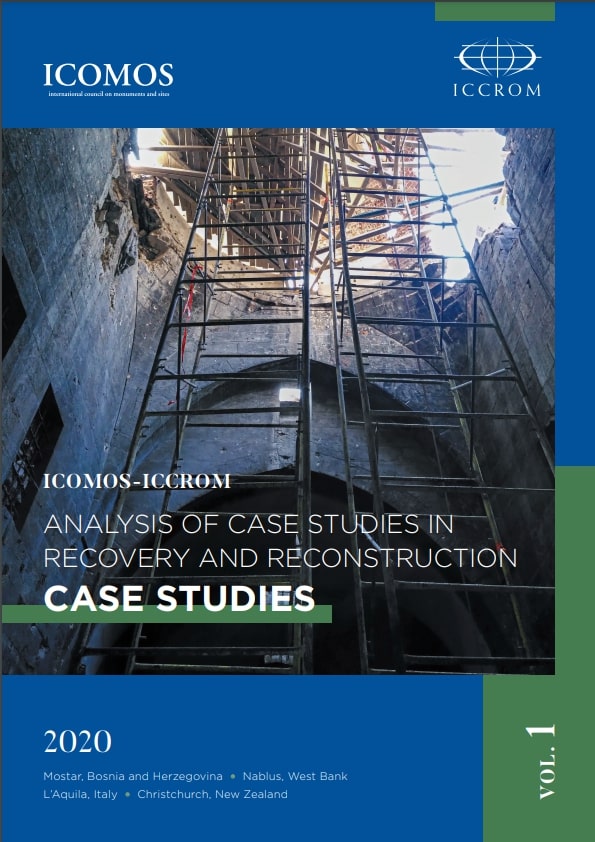
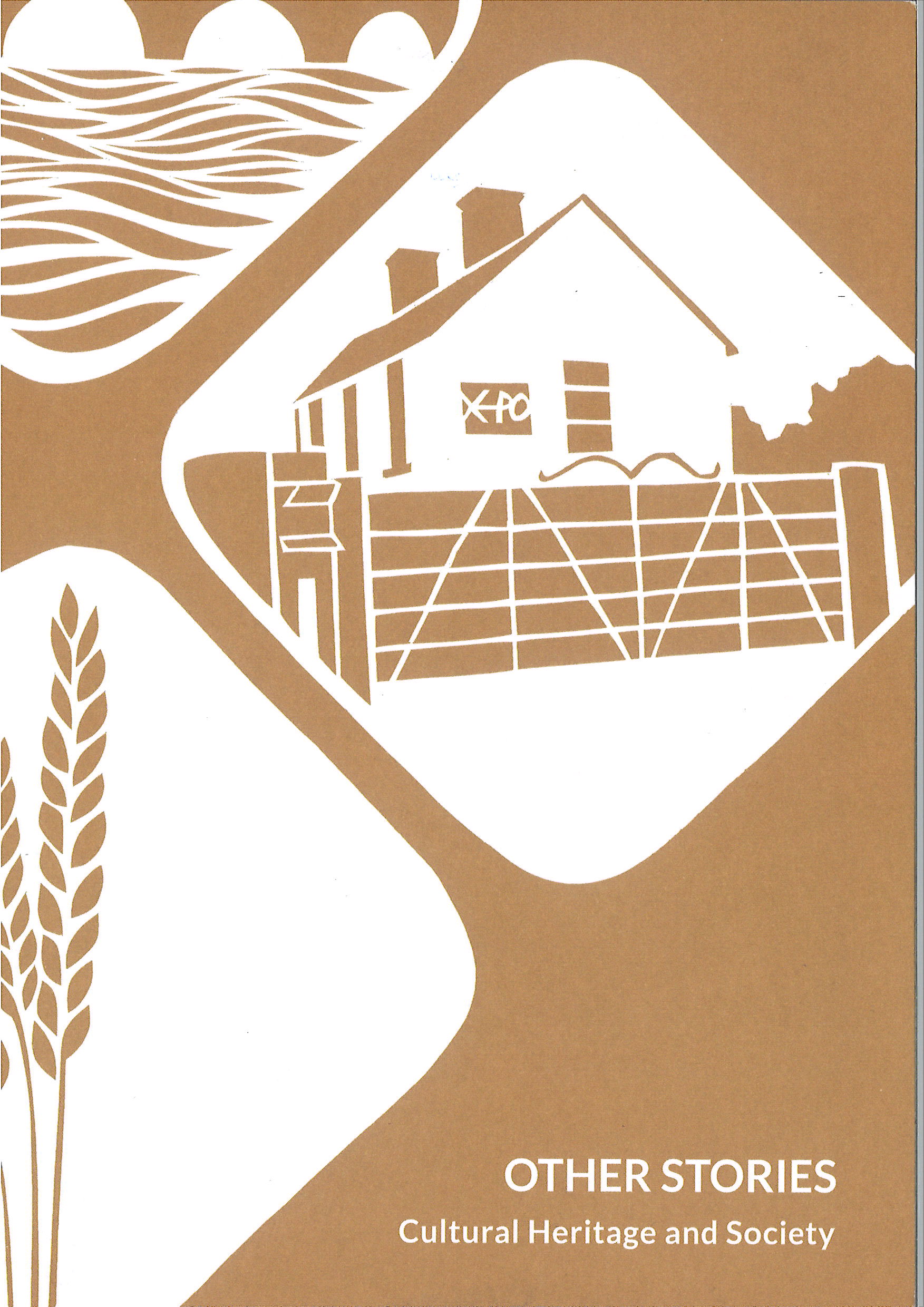
 Béton(s). Architectures en bétons dans les Alpes; restaurer les bétons, la masse et l'épiderme. Proceedings of the international symposium organized by ICOMOS France, Labex AE&CC and the Ecole Nationale Supérieure d'Architecture de Grenoble in Grenoble, France, on 23-24 November 2017. Lagneau, Jean-François (ed.). Paris, ICOMOS France, 2017. 181 p., illus. (Les Cahiers d'ICOMOS France, No. 29). [Fre]
Béton(s). Architectures en bétons dans les Alpes; restaurer les bétons, la masse et l'épiderme. Proceedings of the international symposium organized by ICOMOS France, Labex AE&CC and the Ecole Nationale Supérieure d'Architecture de Grenoble in Grenoble, France, on 23-24 November 2017. Lagneau, Jean-François (ed.). Paris, ICOMOS France, 2017. 181 p., illus. (Les Cahiers d'ICOMOS France, No. 29). [Fre] Patrimoine & débats publics : un enjeu citoyen. La protection des patrimoines peut-elles être un processus démocratique ? Proceedings of the international symposium organized by ICOMOS France in Charenton-le-pont, France, les 24-25 novembre 2016. Tilmont, Michèle (ed.), Orozco-Souël, Paola (ed), Gotfried, Cédric (ed). Paris, ICOMOS France, 2017. 104 p., illus. (Les Cahiers d'ICOMOS France, No. 28). [Eng and Por]
Patrimoine & débats publics : un enjeu citoyen. La protection des patrimoines peut-elles être un processus démocratique ? Proceedings of the international symposium organized by ICOMOS France in Charenton-le-pont, France, les 24-25 novembre 2016. Tilmont, Michèle (ed.), Orozco-Souël, Paola (ed), Gotfried, Cédric (ed). Paris, ICOMOS France, 2017. 104 p., illus. (Les Cahiers d'ICOMOS France, No. 28). [Eng and Por]
 ICOMOS International committee on Historic Towns and Villages (CIVVIH)
ICOMOS International committee on Historic Towns and Villages (CIVVIH)

 Modern Conservation
Modern Conservation


 Kernkraftwerke : DenKmalwerte und Erhaltungschancen / Nuclear Power Stations: Heritage Values and Preservation Perspectives. Brandt, SIgrid et Thorsten, Dame (ed.). Berlin, Hendrik Bäβler Verlag, 2019. 128 p., illus. (ICOMOS Hefte des Deutschen Nationalkomitees, LXVIII) [Ger and Eng]
Kernkraftwerke : DenKmalwerte und Erhaltungschancen / Nuclear Power Stations: Heritage Values and Preservation Perspectives. Brandt, SIgrid et Thorsten, Dame (ed.). Berlin, Hendrik Bäβler Verlag, 2019. 128 p., illus. (ICOMOS Hefte des Deutschen Nationalkomitees, LXVIII) [Ger and Eng] Modern neu denken: Architektur und Städtebau des 20. Jahrhunderts, zwischen Avantgarde und Tradition / Rethinking Modernity: Architecture and Urban planning of the 20th Century, between Avant-Garde and Tradition. Ziesemer, John (ed.). Berlin, Karl Krämer Verlag Stuttgart, 2019. 192 p., illus. (ICOMOS Hefte des Deutschen Nationalkomitees, LXIX) [Ger andEng]
Modern neu denken: Architektur und Städtebau des 20. Jahrhunderts, zwischen Avantgarde und Tradition / Rethinking Modernity: Architecture and Urban planning of the 20th Century, between Avant-Garde and Tradition. Ziesemer, John (ed.). Berlin, Karl Krämer Verlag Stuttgart, 2019. 192 p., illus. (ICOMOS Hefte des Deutschen Nationalkomitees, LXIX) [Ger andEng] Climate risk assessment for heart of neolithic Orkney World Heritage property. Day JC, Heron SF, Markham A, Downes J, Gibson J, Hyslop E, Jones RH, Lyall A. Edinburgh, Historic Environment Scotland, 2019. 88 p. [Eng]
Climate risk assessment for heart of neolithic Orkney World Heritage property. Day JC, Heron SF, Markham A, Downes J, Gibson J, Hyslop E, Jones RH, Lyall A. Edinburgh, Historic Environment Scotland, 2019. 88 p. [Eng] ICOMOS tiesību avoti kultūras mantojuma aizsardzībā. Lejnieks, Janis (ed.). Riga, ICOMOS Latvia / "Petergailis" publishing house, 2018. 167 p. [Lav]
ICOMOS tiesību avoti kultūras mantojuma aizsardzībā. Lejnieks, Janis (ed.). Riga, ICOMOS Latvia / "Petergailis" publishing house, 2018. 167 p. [Lav] Retour à l'esprit de la Charte de Venise / Back to ths spirit of the Venice charter. Summary and conclusions of the seminar organized by ICOMOS France. Mouton, Benjamin (ed.), Schneider, Dominique (ed.). Paris, ICOMOS France, 2019. 43 p. [Fre & Eng]
Retour à l'esprit de la Charte de Venise / Back to ths spirit of the Venice charter. Summary and conclusions of the seminar organized by ICOMOS France. Mouton, Benjamin (ed.), Schneider, Dominique (ed.). Paris, ICOMOS France, 2019. 43 p. [Fre & Eng] Management of cultural heritage sites / Upravljanje kulturne dediscine. Book of abstracts / Kniga povzetkov. 3rd International Symposium on Cultural Heritage and Legal Issues, Bled, 20-22 September 2018. Ifko, Sonja (ed.). Ljubljana, ICOMOS Slovenija, 2018. 51 p. [Slo & Eng]
Management of cultural heritage sites / Upravljanje kulturne dediscine. Book of abstracts / Kniga povzetkov. 3rd International Symposium on Cultural Heritage and Legal Issues, Bled, 20-22 September 2018. Ifko, Sonja (ed.). Ljubljana, ICOMOS Slovenija, 2018. 51 p. [Slo & Eng] Protection and Reuse of Industrial Heritage: Dilemmas, Problems, Examples. Ifko, Sonja (ed.), Stokin, Mario (ed.). Ljubljana, ICOMOS Slovenija, 2018. 147 p. (Monographic publications of ICOMOS Slovenia, 2). [Eng]
Protection and Reuse of Industrial Heritage: Dilemmas, Problems, Examples. Ifko, Sonja (ed.), Stokin, Mario (ed.). Ljubljana, ICOMOS Slovenija, 2018. 147 p. (Monographic publications of ICOMOS Slovenia, 2). [Eng] Dediščina Slovenije in UNESCO / Heritage of Slovenia and UNESCO. Ribnikar Vasle, Biserka (ed.). Ljubljana, ICOMOS Slovenia (in cooperation with the Office of the Slovenian National Commission for UNESCO), 2016. 83 p. [Slo & Eng]
Dediščina Slovenije in UNESCO / Heritage of Slovenia and UNESCO. Ribnikar Vasle, Biserka (ed.). Ljubljana, ICOMOS Slovenia (in cooperation with the Office of the Slovenian National Commission for UNESCO), 2016. 83 p. [Slo & Eng] ICOMOS Korea / ISCARSAH
ICOMOS Korea / ISCARSAH
 The cultural landscape of the Wendland Circular Villages. Proceedings of the 2016 conference and annual meeting of ICOMOS CIAV held in Wendland, Germany, on September 28-October 2, organised with ICOMOS Germany, the State Office for Monument conservation and Archaeology of Lower Saxony and the Samtgemeinde of Lüchow-Wendland . Machat, Christoph (ed.). Berlin, Geymüller, Verlage fÜr Architektur, Aachen, 2018, 111 p., illus. (ICOMOS Hefte des Deutschen Nationalkomitees, LXVII) [Eng]
The cultural landscape of the Wendland Circular Villages. Proceedings of the 2016 conference and annual meeting of ICOMOS CIAV held in Wendland, Germany, on September 28-October 2, organised with ICOMOS Germany, the State Office for Monument conservation and Archaeology of Lower Saxony and the Samtgemeinde of Lüchow-Wendland . Machat, Christoph (ed.). Berlin, Geymüller, Verlage fÜr Architektur, Aachen, 2018, 111 p., illus. (ICOMOS Hefte des Deutschen Nationalkomitees, LXVII) [Eng]
 Modern Conservation No. 6. Šekaric, Branka (ed.). Belgrade, ICOMOS Serbia, 2018, 337 p., illus. [Ser, Eng]
Modern Conservation No. 6. Šekaric, Branka (ed.). Belgrade, ICOMOS Serbia, 2018, 337 p., illus. [Ser, Eng]
 Polar Settlements: Location, Techniques and Conservation. A compilation of presentations made to the IPHC conference held in Punta Areans, Chile in April 2010. 100 p., illus.
Polar Settlements: Location, Techniques and Conservation. A compilation of presentations made to the IPHC conference held in Punta Areans, Chile in April 2010. 100 p., illus. CIPA Heritage Documentation: Best practices and applications. Athens: CIPA, 2011. 103 p., illus.
CIPA Heritage Documentation: Best practices and applications. Athens: CIPA, 2011. 103 p., illus. ICOMOS Monuments and Sites Vol. XV: ICOMOS-ISCS: Illustrated glossary on stone deterioration patterns / Ilustrovaný glosár proveju poskození kamene. Paris: ICOMOS-ISCS, 2008. 78 p., illus.
ICOMOS Monuments and Sites Vol. XV: ICOMOS-ISCS: Illustrated glossary on stone deterioration patterns / Ilustrovaný glosár proveju poskození kamene. Paris: ICOMOS-ISCS, 2008. 78 p., illus. The image of Heritage - Changing perception, permanent responsibilities. Proceedings of the International Conference of the ICOMOS International Scientific Committee for the Theory and the Philosophy of Conservation and Restoration, 6-8 March 2009, Florence, Italy. Ed. by Tomaszewski, Andrzej and Giometti, Simone. Florence, Edizioni Polistampa, 2011. 346 p., illus.
The image of Heritage - Changing perception, permanent responsibilities. Proceedings of the International Conference of the ICOMOS International Scientific Committee for the Theory and the Philosophy of Conservation and Restoration, 6-8 March 2009, Florence, Italy. Ed. by Tomaszewski, Andrzej and Giometti, Simone. Florence, Edizioni Polistampa, 2011. 346 p., illus. Integrity and authenticity in modern movement architecture: Case Paimio hospital. Outcomes of the International expert seminar, 1-2 October 2009 in the Paimio hospital, Finland. Ed. by Salastie, Riita. Helsinki, ICOMOS National Finnish Committee, 2010. 123 p., illus.
Integrity and authenticity in modern movement architecture: Case Paimio hospital. Outcomes of the International expert seminar, 1-2 October 2009 in the Paimio hospital, Finland. Ed. by Salastie, Riita. Helsinki, ICOMOS National Finnish Committee, 2010. 123 p., illus.